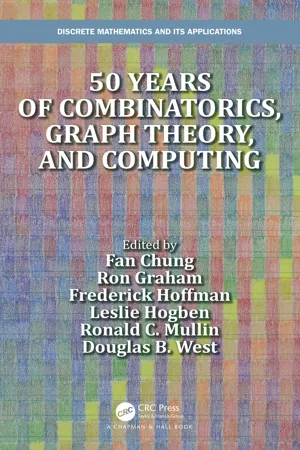
50 years of Combinatorics, Graph Theory, and Computing
Fan Chung, Ron Graham, Frederick Hoffman, Ronald C. Mullin, Leslie Hogben, Douglas B. West, Fan Chung, Ron Graham, Frederick Hoffman, Ronald C. Mullin, Leslie Hogben, Douglas B. West
- 416 pages
- English
- ePUB (mobile friendly)
- Available on iOS & Android
50 years of Combinatorics, Graph Theory, and Computing
Fan Chung, Ron Graham, Frederick Hoffman, Ronald C. Mullin, Leslie Hogben, Douglas B. West, Fan Chung, Ron Graham, Frederick Hoffman, Ronald C. Mullin, Leslie Hogben, Douglas B. West
About This Book
50 Years of Combinatorics, Graph Theory, and Computing advances research in discrete mathematics by providing current research surveys, each written by experts in their subjects.
The book also celebrates outstanding mathematics from 50 years at the Southeastern International Conference on Combinatorics, Graph Theory & Computing (SEICCGTC). The conference is noted for the dissemination and stimulation of research, while fostering collaborations among mathematical scientists at all stages of their careers.
The authors of the chapters highlight open questions. The sections of the book include: Combinatorics; Graph Theory; Combinatorial Matrix Theory; Designs, Geometry, Packing and Covering. Readers will discover the breadth and depth of the presentations at the SEICCGTC, as well as current research in combinatorics, graph theory and computer science.
Features:
-
- Commemorates 50 years of the Southeastern International Conference on Combinatorics, Graph Theory & Computing with research surveys
-
- Surveys highlight open questions to inspire further research
-
- Chapters are written by experts in their fields
-
- Extensive bibliographies are provided at the end of each chapter
Frequently asked questions
Information
Table of contents
- Cover
- Half Title
- Series Page
- Title Page
- Copyright Page
- Dedication
- Contents
- Preface
- Editors
- Contributors
- 1. Personal Reflections of the SEICCGTC: Origins and Beyond
- Part I: Combinatorics
- Part II: Graph Theory
- Part III: Combinatorial Matrix Theory
- Part IV: Designs, Geometry, Packing and Covering
- Index